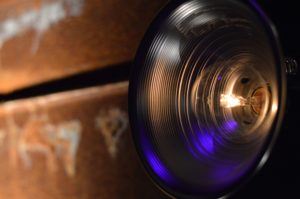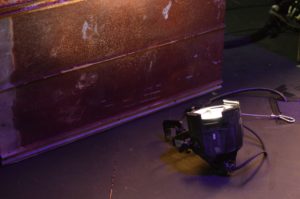Our church makes a regular practice to update their stage design 3-4 times a year. A new design is normally introduced for Christmas, New Years, Easter and one towards the end of Summer. This set design recycled components from the Christmas set and was repurposed for Easter.

The concept for this new design uses old metal roofing, recycled wood, and painters light…fairly simple, right?
Each panel is 16 feet tall and 4 feet wide attached to a 2×2 wood frame on the back. The panels are connected by pieces of 2×4 painted black which the painter’s lights are secured to.
Rusted metal roofing and weathered wood panels were rescued or donated and cut into 4 foot wide segments at no cost. Volunteers then laid out the wood and metal in a planned “random” pattern with different sizes of wood and metal alternating.
All 10 panels were assembled in about two days using 100% volunteer help. Similar materials could be purchased at your local home improvement store and weathered yourself though this would add time and cost to this project.
The old stage was struck on a Sunday afternoon after the morning worship service. The 10 panels were brought in and secured to each other by black 2×4 pieces. Above each panel, paracord was used to secure the panels to existing trussing above the stage. The panels were also bolted into the stage for extra safety and to keep them from moving.

Lighting was set up the next day by 2 people. A total of 36 painters can lights with Edison bulbs were installed in four rows, 4 high. They were installed in increments 3 feet apart starting at 15 feet high (1 foot down from the highest point, and 6 foot high at the lowest). All of these were connected together and each horizontal row was assigned a dimmer so that the rows could roll for a lighting effect up and down.

A par can light with a traditional 750-watt bulb was placed at the base of each panel to provide an up light effect. All of these were wired together on one dimmer row and could be used in conjunction with the painter’s lights to fade in and out.
Total costs were $250-300 due to a majority of the materials being donated.
View additional pictures at https://flic.kr/s/aHskFQuHXF.
